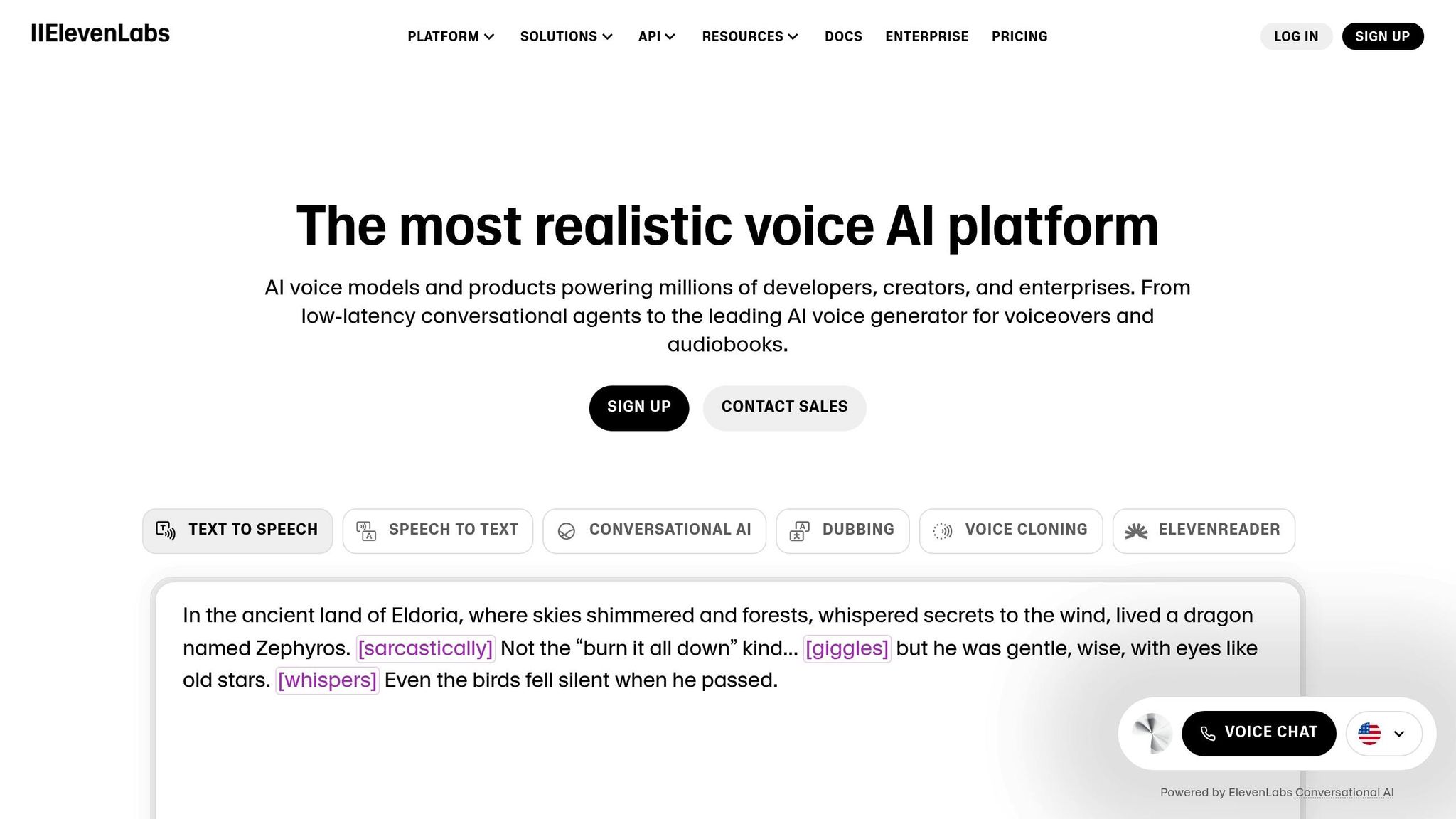Voice-driven branding is changing how businesses connect with audiences. By using tools like ElevenLabs, companies can create tailored, consistent audio experiences that resonate across platforms. Here’s why it matters:
- 77% of consumers base purchasing decisions on brand names, and 90% value transparency. A consistent voice builds trust and recognition.
- AI tools like ElevenLabs simplify creating and scaling a brand voice, offering features like voice cloning, multilingual support, and AI dubbing.
- Audio campaigns achieve a 96% recall rate, outperforming visuals alone.
For U.S. businesses, this means stronger customer loyalty, better engagement, and increased revenue. ElevenLabs’ tools also streamline operations, from customer service to marketing, while ensuring security and compliance standards. The key is aligning these tools with your brand’s identity to deliver a unified, impactful voice across all interactions.
How to Make UNIQUE Voices with AI - NEW ElevenLabs Voice Design

ElevenLabs Features for Business Use
ElevenLabs has attracted over 1 million registered users, including 41% of Fortune 500 companies, in a speech recognition market expected to hit $56.1 billion by 2030 [1]. Its tools are tailored for businesses seeking cutting-edge voice and language solutions.
Text-to-Speech and Voice Cloning
ElevenLabs offers advanced tools for businesses to create a consistent and engaging brand voice. Its voice cloning technology allows companies to generate personalized, emotionally resonant voices. Businesses can choose between Instant Voice Cloning (IVC) for quick results using short audio samples and Professional Voice Cloning (PVC) for high-quality, data-rich voice replicas [2].
Several organizations have already seen transformative results with ElevenLabs:
- Paradox Interactive: Reduced audio generation timelines from weeks to mere hours.
- Chess.com: Enhanced interactive tutorials with AI-powered narration.
- HarperCollins: Streamlined audiobook production via the Projects platform [1].
Additionally, the platform includes an AI Speech Classifier to verify whether audio was generated by ElevenLabs' system, ensuring transparency and authenticity [2].
Language Support and Localization
ElevenLabs empowers U.S. businesses to connect with global audiences through its extensive language capabilities. The Eleven v3 model supports over 70 languages, enabling businesses to create natural, regionally accurate content for diverse markets [3][4].
| Model | Languages Supported | Best For |
|---|---|---|
| Eleven v3 | 70+ languages | Human-like, expressive speech generation |
| Multilingual v2 | 29 languages | Emotionally rich, lifelike quality |
| Flash v2.5 | 32 languages | Real-time applications (~75ms response time) |
The platform also offers over 750 high-quality voices, each marked with an HQ badge, designed for natural pronunciation and accurate regional accents [5][6]. For American English, curated voice collections provide businesses with a variety of native-sounding options.
ElevenLabs' AI dubbing technology takes localization further by translating and dubbing content into multiple languages while maintaining the original speaker's voice, emotion, and style [7]. Examples of success include:
- Praktika: Boosted student engagement by 15%.
- CreatorKit: Improved conversion rates by 16% [9].
Tessya Federico, Director of Partnerships at Elise AI, highlights the impact of this technology:
"Their voice technology has allowed us to create AI agents that not only sound natural but can also communicate fluently in multiple languages. This has been a game-changer for healthcare providers and patients in diverse communities" [9].
Enterprise Features for U.S. Companies
ElevenLabs also addresses the critical needs of U.S. businesses with robust enterprise features. Security and compliance are top priorities, with the platform meeting SOC2 and GDPR standards, offering Zero Retention Mode, end-to-end encryption, and Business Associate Agreements (BAAs) for HIPAA compliance. It also supports EU Data Residency and adheres to CCPA requirements [9][10].
Igor Yermakov, Co-founder & CTO of Solda.AI, underscores the platform's reliability:
"We work extensively with banks and financial institutions demanding the highest standards. With ElevenLabs, we match their strict requirements" [9].
Additional enterprise features include:
- Unlimited user seats and asset sharing
- Custom Single Sign-On (SSO) integration
- Dedicated support teams
- Tailored Service Level Agreements (SLAs) [9][10]
The platform’s API offers a wide range of tools, from text-to-speech and speech-to-speech conversion to sound effects, dubbing, and conversational AI. These features integrate seamlessly into existing workflows, enabling businesses to enhance their operations with ease [1].
Pricing for enterprise solutions is usage-based, with conversational AI starting at $0.08 per minute and speech transcription at $0.22 per hour. Custom pricing options, based on credits and seats, ensure scalability for large implementations. For example:
- Convin: Increased customer satisfaction scores by 27%.
- Gaia: Reduced dubbing time by 25% and cut costs by 10% [9].
Business Applications for Voice-Driven Brands
Voice-driven branding is reshaping how businesses connect with customers, offering AI-powered audio experiences that are efficient, engaging, and tailored to individual needs. Let’s explore some of the ways this technology is transforming industries.
Creating Personalized Customer Experiences
Customer service is one of the most impactful areas for voice-driven branding. Traditional customer support often disappoints, with 61% of customers abandoning companies due to poor service [11]. Enter ElevenLabs, which enables natural, human-like interactions 24/7, ensuring customers feel heard and valued. These AI systems handle routine inquiries, manage multiple tasks simultaneously, and analyze customer data to offer personalized recommendations based on individual preferences.
Take Stanford Health Care, for example. By implementing an AI-powered voice dialer, they streamlined appointment scheduling, medication reminders, and follow-up care. Using natural language processing, the system adapted to patient responses, cutting no-show rates by 25% and boosting patient satisfaction [11]. Brands can further enhance these systems by selecting AI voices that align with their personality, adjusting tone and accent as needed. With 75% of customers preferring multi-channel interactions - voice, chat, and messaging apps included [11] - voice-driven solutions offer a clear competitive edge.
Beyond customer service, voice technology is revolutionizing marketing and content creation.
Improving Marketing and Content Creation
Marketing teams are leveraging ElevenLabs to maintain consistent brand voices across various content formats while keeping costs in check. The global AI voice generator market, valued at $3.564 billion in 2023, is projected to grow at an impressive 29.6% CAGR through 2030 [14]. Voice cloning technology enables professional voiceovers for marketing campaigns, product demos, and educational materials without the need for repeated casting [12]. This ensures consistency while allowing brands to tailor messages for different demographics and markets.
For instance, Netflix personalized its user experience by customizing home screens based on viewer behavior, helping the platform reach 260 million paid subscribers by Q4 2024 [13]. Similarly, Moments Lab’s MXT-2 technology speeds up video production, creating highlight reels up to seven times faster than traditional methods. Clients like Warner Bros Discovery and Hearst have used this to double their social media revenue [13]. Additionally, text-to-speech narration for visually impaired users not only improves accessibility but also underscores a company’s commitment to inclusivity and social responsibility [12].
Voice-driven branding doesn’t stop at marketing - it also streamlines operations across various industries.
Automating Voice-Based Systems
ElevenLabs integrates seamlessly with platforms to power voice-driven solutions for customer service, sales, and even internal operations. A standout example is ING Bank in Turkey, which implemented an AI-powered Interactive Voice Response (IVR) system for handling customer service calls. This advanced system reduced the workload of human agents by 50% and increased customer payment promises by nearly 60% [16].
The integration capabilities of voice technology extend far beyond customer service. Platforms like Lyzr Agent Studio and Callin.io use ElevenLabs voices to enhance operational efficiency, boosting customer engagement by 35% [8][15]. Twilio’s integration with generative AI voice technology achieves latency as low as 75 milliseconds, enabling smooth, natural conversations [17].
Voice automation also plays a key role in internal training. AI voices deliver consistent messaging for educational content across global teams, reducing costs tied to recording and updating materials in multiple languages and accents. Innovative applications, such as Lyzr’s AI-driven AMA bots - like the Phil Fersht AMA Bot - create interactive and engaging experiences while preserving a brand’s authentic voice [15].
Voice-driven branding is not just a trend; it’s a powerful tool for improving customer experiences, streamlining operations, and elevating marketing efforts. It’s clear that businesses adopting this technology are setting themselves up for long-term success.
sbb-itb-9cd970b
Implementation and Integration Best Practices
Bringing ElevenLabs into your workflow involves securing API access, aligning with both technical and brand requirements, and addressing ethical considerations right from the start.
Steps to Integrate ElevenLabs into Workflows
Start by retrieving your API key during account setup and treat it like a password - it’s crucial to keep it secure [18]. If you're a Salesforce user, use Named Credentials to handle authentication seamlessly.
The technical setup begins with installing the ElevenLabs Python package via pip. From there, you’ll need to create integration logic using Apex callouts, which allow Salesforce systems to make secure outbound HTTP requests to ElevenLabs' services [18]. To ensure smooth operations, adopt asynchronous processing to bypass system limits and deliver a seamless user experience [18]. Don’t forget to build robust error handling and logging mechanisms to quickly pinpoint and resolve any issues [18].
Next, make your integration methods accessible to workflow systems. In Salesforce, this involves adding the @InvocableMethod annotation to Apex methods, enabling them to interact with Flow automation [18]. This setup allows you to create record-triggered workflows that can automatically generate and deliver voice messages based on specific business events.
Before rolling out your integration, test it thoroughly in a sandbox environment. Simulate error scenarios and high-traffic conditions to ensure reliability [18]. For example, in November 2024, ElevenLabs showcased how their Conversational AI integration with HubSpot empowered marketing teams to speed up content creation, improve customer engagement, and nurture leads more effectively through natural conversations [19].
Once the technical groundwork is laid, focus on aligning the system with your brand’s voice for a cohesive experience.
Maintaining Brand Consistency
After completing the technical setup, shift your attention to maintaining a consistent brand identity. Start by documenting your brand’s voice, including its tone, personality, and values. This serves as a guide for all AI-generated content [20][22].
To train the AI effectively, feed it high-quality content that reflects your brand’s style. Use detailed prompts to steer the AI in the right direction, ensuring it produces content that aligns with your brand’s identity. This approach strengthens personalized customer experiences, fostering engagement and loyalty [20][22].
Even with advanced AI, human oversight is essential. Establish regular review processes where team members evaluate AI-generated content to confirm it aligns with your brand voice. This collaboration between human expertise and AI ensures quality and prevents deviations [20][22].
As your brand evolves, update your brand voice guidelines to keep the AI aligned with any shifts in positioning or audience expectations. Schedule periodic reviews to ensure the guidelines remain relevant. Continuously test and refine the system to address any inconsistencies in the AI’s output [20].
For businesses operating across different regions, localization is key. Adapt your tone to fit the cultural context of each market while staying true to your brand’s core identity. This ensures your messaging resonates with local audiences without losing its essence [21].
Managing Ethics and Security Concerns
With the technical and branding aspects in place, it’s critical to address ethical and security considerations to safeguard your voice technology. Always obtain explicit consent from individuals whose voices are being cloned, establishing clear protocols to protect both your business and contributors [24].
Implement robust data security measures. Encrypt voice samples, use access controls to prevent unauthorized use, and anonymize speech data by removing personally identifiable information. Enhance security further with multi-factor authentication alongside voice recognition systems [24][26].
The rise in voice fraud, highlighted by Pindrop’s report of a 350% increase in incidents from 2013 to 2017, underscores the importance of these measures [24]. Consider adding watermarking or unique identifiers to synthetic voices to enable tracking and verification [27].
"Understand that this technology has both positive and negative uses, and mitigate risks during product development. When we onboard our users to make sure that they have permission for voice that won't replicate. It's not only to make it like providing permissions to the owner of your voice because if your owner voice and you want to monetize it, it's totally okay."
– Anna Bulakh, Respeecher's head of ethics [23]
Develop a code of ethics within your organization to guide decisions around voice cloning. This framework can help prevent misuse and ensure responsible applications of the technology. Be transparent with customers by clearly disclosing when AI-generated voices are being used [26].
Transparency builds trust. Share details about your use of voice cloning technology while maintaining robust security protocols. Regular audits will help you stay compliant with ethical standards and evolving regulations [24].
Finally, stay informed about intellectual property laws to avoid infringing on copyrights or replicating well-known personalities without permission. As AI regulations continue to develop, adapt your practices to remain compliant across all regions where your business operates [25].
Measuring Impact and Scaling Voice Initiatives
Understanding how your voice initiatives perform is essential for growth. The right metrics not only highlight successes but also reveal areas for improvement, helping you make informed decisions as you scale.
Key Performance Indicators for Success
To measure the success of your voice branding efforts, focus on KPIs that tie directly to business growth. For example, Brand Voice Alignment ensures AI-generated content consistently represents your brand's identity. Metrics like Time-to-Publish and Cost-to-Write can track how efficiently your team creates and deploys content, with research suggesting that AI tools can reduce costs by up to 10x compared to traditional brand writing teams [29].
Other useful KPIs include:
- Brand Voice Awareness: Measures how well customers recognize your brand's voice.
- Perception of Brand Voice Values: Tracks whether customers associate your brand with the qualities you aim to promote.
- Thought Leadership Perception: Evaluates your positioning as an authority in your industry.
For voice interactions, monitor metrics like conversation completion rates, session durations, and satisfaction scores. Public perception can also be gauged through sentiment analysis of brand mentions on social media and review platforms.
Additionally, track improvements in content creation efficiency, such as faster production times, fewer revisions, and increased output per hour. These metrics demonstrate the tangible benefits of your voice branding investment.
Focus on KPIs that align with your business objectives, and regularly review them to ensure they remain relevant as your strategy evolves [28][30].
Calculating ROI for Voice Branding
After tracking performance, it's crucial to quantify your return on investment (ROI) to show how voice branding efforts contribute to your bottom line. Start by setting clear objectives, such as boosting awareness, improving customer loyalty, or expanding accessibility.
Direct returns might include increased sales from voice-powered campaigns, new customer sign-ups through voice channels, or cost savings from automating processes. For example, compare revenue from customers engaging with voice initiatives to those who don’t.
Indirect returns offer long-term value, like higher customer lifetime value, more referrals, and broader market reach through improved accessibility.
To calculate ROI, use the formula:
(Net Profit / Total Costs) × 100.
Here, Net Profit equals Gross Revenue minus Total Costs. Be sure to account for expenses like ElevenLabs subscription fees, integration development, staff training, and maintenance.
Keep in mind that results vary by timeframe. For instance, content production efficiency might improve immediately, while shifts in brand perception could take 6–12 months. Research shows that incorporating branded audio elements can boost brand recognition by up to 69%, and shoppers exposed to these experiences may spend up to 38% more [31].
Scaling with ElevenLabs Enterprise Solutions
Once you’ve measured ROI, you can confidently scale your voice initiatives. Building on earlier efforts to integrate technology and maintain brand consistency, consider creating a Center of Content Excellence (CCE). This centralized hub can house your voice branding resources, including style guides, training materials, and best practices [32].
ElevenLabs Enterprise solutions offer robust APIs and processing capabilities to handle high-volume voice generation. AI tools can automatically check spelling, grammar, tone, style, and keyword compliance, ensuring your brand voice stays consistent without the need for manual reviews [32].
Approach your voice branding rollout like a marketing campaign. Set clear goals, define success metrics, and appoint brand voice champions within each department. Provide diverse training options, such as workshops, video tutorials, and hands-on sessions, to ensure everyone is equipped to use the tools effectively [32].
If your business spans multiple regions, adapt your voice branding to local preferences while maintaining your core identity. Use automated tools to monitor adherence to voice guidelines, set up alerts for deviations, and regularly survey customers to assess effectiveness [32].
Finally, establish feedback loops across teams using voice technology. Insights from customer service, marketing, and sales can help refine your strategy, ensuring your brand voice remains strong and effective as you scale.
Conclusion and Key Takeaways
Voice-driven branding has become a powerful tool for businesses in the U.S., offering a way to stand out in a competitive market. ElevenLabs is leading this shift, providing tools that make voice synthesis accessible for businesses of all sizes. With its advanced AI, ElevenLabs produces speech that mirrors the subtleties of human communication, helping brands forge genuine connections with their audiences across various platforms.
The numbers back up its importance. 80% of consumers are more likely to buy from brands that deliver personalized experiences [34], and the global AI voice market is expected to hit $3.5 billion by 2026 [35]. Companies that have adopted ElevenLabs’ solutions report noticeable improvements in customer engagement and satisfaction, demonstrating the real-world impact of this technology.
What sets ElevenLabs apart is its features, such as voice cloning, which enables brands to deliver tailored experiences on a large scale. With flexible pricing starting at just $5 per month [33], it’s a solution that works for both startups and large enterprises. By integrating seamlessly into your existing voice branding efforts, ElevenLabs makes it easier to maintain a consistent and personalized brand voice.
The real advantage comes from combining consistency with personalization. When businesses use a unified voice across all customer interactions - whether in marketing, customer service, or beyond - they build trust and recognition, which often translates into higher revenue. Adjusting tone to match the emotions of your audience strengthens connections and boosts loyalty.
To succeed with voice branding, focus on strategic planning, consistent execution, and regular performance measurement. These steps will position your business as a leader in an increasingly voice-focused world. While ElevenLabs provides the tools, the key to success lies in using them to craft a brand voice that resonates deeply with your customers and drives measurable results.
FAQs
How does ElevenLabs ensure AI-generated voices are authentic and used responsibly?
ElevenLabs employs sophisticated voice verification technology to safeguard AI-generated voices and prevent misuse. This approach ensures that voices cannot be cloned without authorization, reinforcing ethical and secure applications.
Their tools also focus on producing natural, high-quality voice replicas that inspire confidence and maintain openness. By emphasizing responsible AI practices, ElevenLabs helps businesses enhance their reputation while utilizing advanced voice synthesis technology.
How can businesses effectively integrate ElevenLabs' voice technology into their workflows while maintaining a consistent brand identity?
To make the most of ElevenLabs' voice technology in your workflows, start by creating scripts that feel natural and match your brand's unique tone. This ensures the generated voices sound authentic and engaging. Then, leverage APIs to integrate the tool smoothly with your current systems, whether that's customer service platforms, marketing tools, or other software you rely on.
Fine-tuning prompts is key to achieving lifelike, engaging voice responses that connect with your audience. At the same time, make sure you're upfront with customers about the use of AI-generated content - transparency is essential for building trust. Regularly check and adjust the audio quality to maintain alignment with your brand's identity and ensure a polished, professional output.
By focusing on these strategies, you can craft a voice-driven experience that strengthens your brand and leaves a lasting impression.
How can businesses evaluate the ROI of using AI-powered tools like ElevenLabs for building a voice-driven brand?
Businesses can measure the return on investment (ROI) of voice-driven branding tools by tracking key performance indicators like boosted brand recognition, enhanced customer interaction, and noticeable revenue increases.
To start, dive into metrics such as customer feedback, engagement rates, and sales conversions linked to voice interactions. Tools like surveys and analytics can shed light on how voice branding influences customer satisfaction and loyalty. Attribution models also play a crucial role, connecting voice-driven campaigns to real-world results, such as increased sales or lower customer service expenses.
Regularly reviewing these metrics provides businesses with a clear understanding of how voice solutions impact their overall performance and growth.



